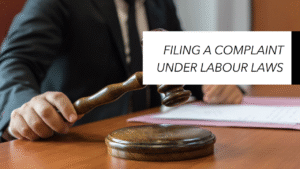Legal Complaint Filing Made Easy: Beginner’s Guide
Legal Complaint Filing: A Step-by-Step Guide

Legal Complaint Filing is the first step in taking formal legal action against a person, business, or organization. Whether you’re dealing with a civil dispute, contract breach, workplace issue, or any other matter, understanding the legal complaint process is essential. This article will walk you through what a legal complaint is, how to file one, and what to expect during the process.
What Is a Legal Complaint?
A legal complaint is a formal written document submitted to a court that outlines your claim or grievance against another party. The person filing the complaint is called the plaintiff, while the person or entity being accused is the defendant. The complaint explains the facts of the case, the legal grounds, and the relief or outcome the plaintiff is seeking (such as compensation, court orders, or other remedies).
Common Reasons for Filing a Legal Complaint:
Legal complaints can arise from many different types of disputes. Some common reasons include:
- Breach of contract
- Unpaid debts
- Property damage
- Personal injury
- Employment issues
- Discrimination or harassment
- Landlord-tenant disputes
- Consumer rights violations
Steps to File a Legal Complaint:
Identify the Proper Court:
Before filing, make sure you file your complaint in the correct jurisdiction (location) and court type (e.g., small claims, civil, family, etc.). The court must have the legal authority to hear your case.
2. Draft the Complaint
The complaint should include:
- Your name and contact information
- The defendant’s name and information
- A clear statement of facts
- The legal basis for your claim
- The relief or compensation you are seeking
3. File the Complaint with the Court:
Submit your complaint to the court clerk. You may need to:
- Pay a filing fee (varies by court)
- Submit multiple copies
- Get a case number assigned

4. Serve the Defendant:
After filing, you must notify the defendant through a process called service of process. This ensures they are legally aware of the case. A copy of the complaint and a court summons is delivered, usually by a process server or sheriff.
5. Wait for the Defendant’s Response:
The defendant has a limited time (usually 20–30 days) to file a response. They may admit, deny, or provide a counterclaim.
6. Proceed with the Case:
If the complaint is accepted and a response is filed, the case may move toward:
- Negotiation or mediation
- Pre-trial motions
- Trial
- Judgment and enforcement
Tips for Filing a Legal Complaint:
- Gather all evidence and documentation before filing.
- Be clear and specific in your complaint. Vague or emotional language can weaken your case.
- Consult a lawyer if your case is complex or involves large sums of money.
- Be aware of the statute of limitations—you must file within a certain time after the issue occurred.
What Happens After Filing?
Once filed, your case will be assigned to a judge. Depending on the situation, you might go through settlement discussions, hearings, or a full court trial. If you win the case, the court will order a judgment in your favor, which may include financial compensation or other remedies.

Conclusion:
Filing a legal complaint is a powerful tool for seeking justice and resolving disputes through the court system. By understanding the steps involved and preparing your case carefully, you improve your chances of a successful outcome. Whether you’re handling a small claims issue or a more serious legal matter, knowing how to file a complaint properly is the foundation of effective legal action.

Post Comment